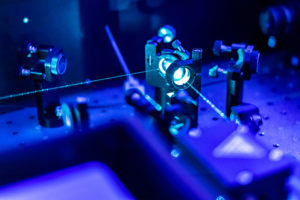Fast switching nanophotonic spatial light modulator

The field of photonic circuits has been gaining significant momentum in recent years. With electronic circuitry reaching its limits, especially in the fields of AI and Machine Learning, the appetite for an alternative is growing. While the initial developments in the area are promising, significant further innovation will be required before we start to see photonic components in our daily lives.
Most current optical circuitry relies on spatial light modulators (SLM), used to generate desired beam profiles and/or to facilitate optical beam steering. In addition, SLMs may also be used for holographic data storage and optical filter implementations. Traditional SLMs are formed using liquid crystals. Switching the refractive index of the liquid crystal components allows the optical signal passing through to be modified – an important feature necessary in optical circuits. However, the switching speeds of these liquid crystals are slow, relative to their electronic counterparts. This is a significant hurdle to creating competitive optical components.
Researchers at Oxford have developed an optical component that is capable of significantly faster switching speeds. This innovation harnesses the properties of phase change materials (PCM) which have the ability to switch easily between states with different refractive indices. Typically the two states are a crystalline state and an amorphous state.
Significantly, the switching speed of these PCMs is much higher than those of conventional SLMs. The switching can be achieved by electronic pulses. But clearly there is a benefit to being able to create a fully optical system.
Switching the state of PCMs in a fully optical system has been achieved through use in a configuration developed by our team here at Oxford.
Two waveguides are arranged to intersect, and the PCM is positioned at the intersection point. The high optical intensity created by two optical pulses meeting at the intersection point leads to switching of the PCM to a different state, in turn applying a predetermined form to the optical pulses. There is huge potential to harness this effect to create a wide range of fully optical components.
Oxford University is seeking commercial partners to help develop the technology and bring it to market together with the research team.
about this technology

